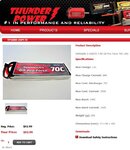ArminVanBuuren
Member level 3
Re: 1 LED @ 2A versus 3 LEDs @ 700mA
Sorry, I was still much hesitant about buying the 3x LED lamp, because of the enormous heat that ONLY ONE LED produces, I feared that this 3 LEDs would be even non-usable.
OK I'm going for the 3x LED CREE lamp then. Still don't know if understand perfectly, but this booster circuit will definitely help reduce some heat. Moreover, the 3x 700 mA current will produce a bit more brightness than 1x 700 mA (single CREE), and also the case temperature will be by 10°C lower compared to the single CREE due to the booster circuit. (Yet, your calculations with no-wind conditions at 25°C is too rough, I think I will ride at highest temp. of 15°C and a bit windy, so I hope I will not reach Tmax of the junction.)
Well, on eBay, they always state much higher values than they really are. But actually, even 2800 mAh cell is really good compared to those that eg. on the YouTube link were.
Could you please advise the seller from who you bought your light? I would check his items, whether he sells those single batteries / battery packs. Even though it is not 3200 mAh as advertised, 2800 mAh is still a way better than those 66 mAh presented on the video :lol:
That's your 3rd time "One last thing", I guess! ;-)
Sorry, I was still much hesitant about buying the 3x LED lamp, because of the enormous heat that ONLY ONE LED produces, I feared that this 3 LEDs would be even non-usable.
Now I think, the decision is clear.
OK I'm going for the 3x LED CREE lamp then. Still don't know if understand perfectly, but this booster circuit will definitely help reduce some heat. Moreover, the 3x 700 mA current will produce a bit more brightness than 1x 700 mA (single CREE), and also the case temperature will be by 10°C lower compared to the single CREE due to the booster circuit. (Yet, your calculations with no-wind conditions at 25°C is too rough, I think I will ride at highest temp. of 15°C and a bit windy, so I hope I will not reach Tmax of the junction.)
The 4 18650 accus delivered with the lamp were blue (sic!) packaged cells labelled UltraFire SX 18650 3200mAh 3.7V . My measurement with 700mA discharge current from 4.2 down to 2.5V resulted in about 2800mAh.
Not too bad, at least no fake. The charger actually stops charging at 4.15 .. 4.2V.
Well, on eBay, they always state much higher values than they really are. But actually, even 2800 mAh cell is really good compared to those that eg. on the YouTube link were.
Could you please advise the seller from who you bought your light? I would check his items, whether he sells those single batteries / battery packs. Even though it is not 3200 mAh as advertised, 2800 mAh is still a way better than those 66 mAh presented on the video :lol:
